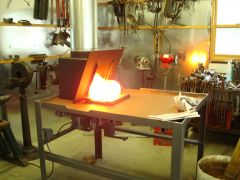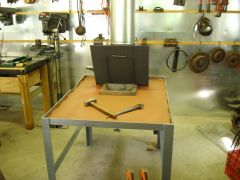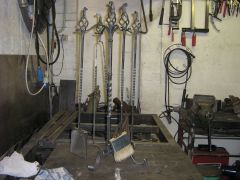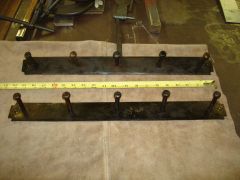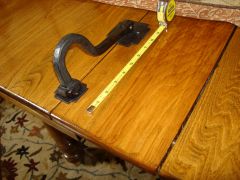-
Posts
745 -
Joined
-
Last visited
Content Type
Profiles
Forums
Articles
Gallery
Downloads
Events
Everything posted by petere76
-
Gents, Remember that the rules of physics still apply. Force=Mass x Acceleration (f=MA). The mass is the smoke and air mixture and the acceleration, in this case increases, with the temp of the mass because the mass can expand (PVT rules apply here). The 45 foot tall stack serves as a very good conduit for the hot gas mixture. Anything directly on top of the stack is considered a design loss not a gain for the stacks efficency. Additionall, any bends, constrictions or irregular (rough) interior surfaces on the stack will decrease the mass acceleration and thus also decrease the systems efficency. The tech aspect of gas flow that is uniform and most efficent is called laminar (flow) and the term for disorganized or inefficent gas flow is called turbulant (flow). Anything uniform (gas or liquid) utilizing a pipe like structure for movement comes under the guise of a mass flow device. Jet engies and antiquated water systems are both governed by the same physical constraints. As a practical example, ask yourself the question "does a duct exhuaster (fan) simply created a vacuum (low pressure) or increase the acceleration of the existing gas flow?" Conventional application in this case, increases the mass flow of the gas on the discharge side thus increasing the available CFM on on the suction side. We end of seeing the increase CFM as a increase of the (stacks) negative pressure. thus the suction is improved at the opening of the forge to the stack. Peter
-
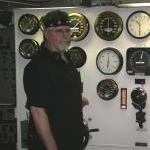
Who wants to be a movie star?
petere76 replied to clinton's topic in Blacksmithing, General Discussion
Clinton, As a suggestion, try one of the many established ironworking shops in CA. The shops are alreay set up with everything the film producer may be looking to capture. Contact the owner and buy the shop time, you get what you negotiate. Bill the project as a commision but without a finished product. Good luck with the project. Peter -
Gents, Along the Francis Whitaker theme...Does anyone know if the second of the Blacksmith's craft volume will be released? The demise of the Blacksmiths Journal publishing group may or may not be a factor if they sold the rights to the publication. Peter
-

Building a sdie draft coal forge
petere76 replied to petere76's topic in Chimneys, Hoods, and Stacks
Tubbe, In regard your question about uptake vs opening dimension. Yes the open should be somewhat smaller for the ideal draft. However, I did make the forge opening adjustable with the sliding closure. Other than during the start-up sequence the volume of smoke produced is actually rather small. I am ver pleased with the draft characteristics through the full range of firing. The face plate in my particular case is .25 in stock and I chose the heaver dimension to preclude any distortion caused by heat. Additionally, the welding process attaching the box (.125 in) to the plate is made easier because you don't have to worry about burn through on the thin parts or any associated distortion. The fabrication was done with a flux cored mig as opposed to a TIG. Good luck with your own design process and production. Post a few pics if you get the chance. Peter -

Building a sdie draft coal forge
petere76 replied to petere76's topic in Chimneys, Hoods, and Stacks
Bill, The forward rake of the face plate does not limit access to the fire pot. Unless your intention is to lower a 8 inch solid piece of iron into the fire I see little chance of any interference. I was suprised at the suction lift on this unit, it is very is very efficent. I can close down the opening with a sliding gate that I use to secure the exhaust when the forge is not operational. At roughly 50 percent open, the hood will still draw a running fire with no smoke in the shop. The first test fire (no forced air) shot out of the fire pot and right into the hood. the side draft concept certainly works as advertised. i'll try and get some pics of the shop. Peter -

Building a sdie draft coal forge
petere76 replied to petere76's topic in Chimneys, Hoods, and Stacks
Still trying to get IFI to accept the photos. -

Building a sdie draft coal forge
petere76 replied to petere76's topic in Chimneys, Hoods, and Stacks
Gents, Other photos of the forge building evolution. -
Coal forge 101. Invest some of your time in identifying your needs and the capabilities of your shop. Once you decide to go with coal, size the forge to both your intended function and your own (personal) working dimensions. Think in terms of the rough height of your anvil (s) and other working surfaces in your shop; save your back. Some of the older HD forge set-ups I have seen in railway yards were built close to the deck because the materials being worked were very heavy. The trade off on these arrangements favored the movement of the work piece rather than the backs of the workers. Be guided accordingly. I decided on a side draft exhaust configuration, as the side draft appears to offer both the best use of the available materials and the space required. The side draft model, when and where properly designed and constructed, offers a very efficient and relatively low loss transition from horizontal to the vertical (smoke direction). To this end, I studied everything I could get my hands on including old New England Rumford Fireplaces and existing masonry working forges dating back to the early 1900s. The side draft was the choice of the pros then and now as well. Other design considerations that are less apparent, include, portability. This consideration favors shops and business circumstances that can change. There is little advantage in building a large, expensive and permanent structure if you have “any” idea of ever moving it. Change being one of the few constants in life, I decided early on in this process to make my shop both modular and where possible as portable as practical. You can’t take it with you when you go… but at least you can move it around while you are still here. The design process, in my particular situation, involved allocating space, sheathing the surrounding bulkheads (fire protection) with sheet steel and accommodating a 10 in through bulkhead insulated uptake system. The uptake and associated ducting is critical to the proper function of the forge and keeping you, your helpers and your building safe. Too small and you suffer the fate of a smoky shop. Too large and you are wasting your money because the material costs outweigh any realized benefits. Materials required for this project were collected over a period of time after some study as to the effectiveness of the various components. The side draft forge design is proven and I went with a modified “super-sucker design as depicted by drawings on the Anvil Fire web site. Modify the opening of the hood face (inlet variable) to that of the uptake dimension inlet (fixed variable pipe size). The inlet to the hood is smaller (sq inches) than that of the uptake exhaust. The differential in area (proportion) supports the acceleration of the flu gasses and thus creates a negative pressure area into which the gases can be drawn. This is best described as a working venturi effect in a gas (mass) flow device. The rule here is (F=MA) force equals mass times acceleration. Table size, 36 in x 48 in. .3125 plate (heavy) for the tabletop and 2.5 x.25 in angle for the frame. The plate was actually a drop acquired from a local steel supplier (Browns Metal) who very much supports our endeavors. Fire Pot is a NEBA 50 Lb casting made in Lewiston Maine for the NEBA. The table was cross supported for the fire pot by additional angle iron to avoid any possible heat distortion that might occur in way of the fire pot. I have seen several forges where the tabletops are heat distorted and the builders were not all that pleased. Tuyer was fabricated by at Ball and Chain Forge in Portland Maine. The Blower is a 120V 60 hz , SC, producing 164 cfm at roughly 40 oz psi. Aluminum air gate and blower both supplied via Blacksmiths Depot. All air connections were machined from reclaimed soil and drain pipefittings and are designed to easily slip together, no fasteners required. The table incorporates various modular sockets around its perimeter to accommodate hangers and or auxiliary shelf mounts. All external mountings are removable to assure a clear path to the fire pot when using long or irregular stock pieces. Both sides of the table feature an extendable stock rack for long work pieces. The side draft forge hood is made of .125 sheet steel plate and attaches to standard 10-inch stovepipe. The plating was CNC plasma cut and bent by a local fabrication shop to our specifications. The variable sliding inlet door was required to both keep the shop warm in the often times chilly Maine winters and still accommodate a reasonable range of fire loading while operational. The project took a realistic 40 hours of shop time, spread over many months, and 1200.00 USD to complete. I did not estimate personal labor or travel time to collect parts. If you can locate the metal chimney sections used, you can do better on the bottom line as that represents a good portion of the cash outlay. I took some photos of the construction process and the finished product. Photos attached for your review. I feel that the project was a success and thus far, the new forge performs very well. IFI in many ways supplied the motivation and the avenues for the research as well as great input from around the world on various designs. Thank you. Peter
-
-
-
-

20 in, 5 peg, Fly Rod Holders, forged& fabricated, exterior oil finish
petere76 posted a gallery image in Member Galleries
-
Sam, There is a reliable design (side draft hood arrangement) that works well for either masonary or sheet construction. Reference the book, "Shop Drawings for Blacksmiths" by Jerry Hoffmann, ISBN 0-9769479-0-0, pages 8,9,10. Although depicted as a steel configuration, the flue and uptake transition is the same in both the masonary structure and the steel fabrication. Both utilize a smoke shelf style design, sit upon a 16 x 24 in footprint and stand 24 in in height. A traditional, reliable and compact design . Peter
-

Uses for metal (what to make what out of)
petere76 replied to Agita's topic in Blacksmithing, General Discussion
Agita, Tried to post pics on the site today but apparently it is not taking photos. Perhaps IFI they should spend less time on fluff such as face book and twitter integration and more time on making the site function as intended. I noted that the forge magic site has no problems loading photos. Peter -

Uses for metal (what to make what out of)
petere76 replied to Agita's topic in Blacksmithing, General Discussion
Agita, I have made tooling out of scrap axles. Treat as you would any HC steel. Normalize, work and then heat treat. Made a small set hammer, for tight corners, out of an old dodge axle and it works great. The flatter was too big a foot print for the piece and I needed more mass in the tool itself to prevent the tool from deforming. This small tool has proved itself well in service. Peter -
Don, 2d for production prints and 3d for conceptual analysis. Rotation is good for mechanical clearances, i.e. doors hinges and other moving parts that need to fit through a range of motion. CAD, compared to mechanical drawing, the end product is the same in both systems. As the manufacturer or the "artist" you still need to conceptualize the final product before you invest the time and materials in the work. 3d projections are a handy tool for our pursuits. Speaking to ACAD specifically, drawing in 3d is not that dfficult because most of the snap point functions transfer. The trick is thinking in 3d as you build the drawing and look for (learn) the appropiate ACAD command lines. As a simple example, circular projections from 2d become elipses in 3d, thus the selection is elipse and you have to pick the projected plane so that the orientation works. Simple stuff but when you are delaing with CAD systems the devil is in the programming and if you don't use these function all the time the learning curve is challenging. Peter
-
Gents, A spiral note book works well. Keep it handy, use it to jot down information and sketch out your ideas or observations. The concept here is to have a handy method to record the ideas and a place to keep them. The KISS principle usually works the best at least from my own perspective. Additionally the notebook process serves a a great rough log of shop activities and good ideas. I have used ACAD for years at work and although it is the engineeeing industry standard it is time consuming in regard data input, it obviously requires the operator to know the program and it is pricey to purchase. The plus side of ACAD is that it draws in full scale, prints to user defined scales and it electronically stores and transferes data. Peter
-
Gents, Two, new "to me", anvils this year( 09-10) . Both located by chance, the 148 #, PW was a Christmas gift from wife and a great surprise. All the edges are decidely worn, the hardy is roughly 1.125" and the rebound is very good. The alleged price of the PW was 100 USD. The second anvil of unkown mfg. came from an old logging area in Northern Maine via a friend. This anvil also went for 100 USD including the well built wooden stand upon which it still resides. Anyone that can ID the anvil manufacturer or supply any supportive data, please chime in. I can see the letters ( I-C-A-N ) on the flank but the other lettering is worn away. The anvil is in great shape with good edges and a good rebound. I have been on the hunt for a larger weight shop anvil but thus far have only been coming across mid-sized finds. As always, the hunt continues. Peter
-
-
Glen, I Forge Iron T spotted on Maine TV. A Smith is running a new school out of a non-profit in Orland Me. He was demonstrating for a news crew (Ch 6 ) and was sporting one of your T's. Good Press. I believe the article was titled "Ancient Arts".
-
Frosty, Great idea on the 2 in tubing grid. I have seen similar set ups in auto shops for pulling bent frames into alignment, very handy. Good to see you on the mend. Peter
-
I found and rebuilt this older vintage SB. Had to fabricate the motor tensioning mechanism and refinish the frame. She runs true and has very little play in the head stock. Also included was old model skinner 3 jaw chuck. She spent most of here previous live in the celler of mans home that ran a dairy farm near the coast in Maine. I had to take it apart to get it through the cellar door and into the truck (heavy). I put some pics in the gallery but it is not up and running yet. Photos attached. Peter
-
Most of the coal forges I have seen dont heat up the ducting or the hood that much. There is obviously some heat in the uptake or the system would not effectively draft. Most of your heat is localized to the coal mass. There is a certain radiant factor next to the foge which you can feel but it's not that much. Side draft hoods seem to work the best in my part of the world. The overhead hood arrangement works well in open buildings but it gets smokey on startup and after a day of breathing the fumes its hard on the operator. Use a min of 10 inch pipe. Going through the wall or the overhead check your building codes as they may require double wall inuslted piping and a 2 in clearance to combustable materials. This is a fairly standard code. If you are going to invest the time and money in the shop, might as well do it right. Peter
-
Try Blacksmith Supply, they have two (chinese) reasonably priced 110 V blowers that will work fine. Skip the variable controller and use the air gate. Remember that you need both CFM and PSI to make everything work according to plan. Cheap fans may have the right CFM but they don't produce the required PSI (inches of H2O). For less than 200 USD you are in the game without any hassels. Good luck Peter
-
HWHII, Consider a packed earth floor. I saw a shop in Maine years ago that was in a pole barn structure. The floor was hard but was not concrete. The owner told me that he compatced the floor with a vibrating compactor and used calcium solution to harden ths surface. In the woods during the summer they use calcium solution to recuce the dust and keep the road way in place. it seemed to work well and it was inexpensive solution. If a power hammer is in your plan, you may have to pour a pad in the area of the hammer footing. Good luck. Peter

